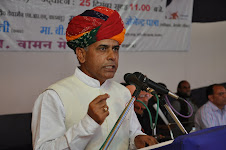ee Media Bureau
Dehradun/Rishikesh: Thousands have perished in flash floods and landslides in Uttarakhand. The holy town of Kedarnath was completely flattened. However, much less than shaking people's faith, the massive tragedy has reinforced their belief in the divine.
For believers, the fact that Kedarnath shrine was left untouched by the deluge and falling rocks presents ample proof of the powers of the divine. Also, the Shivlinga had not gone under the sludge and remained crowned by offerings of belpatra.
The more compelling legend is of Dhari Devi, guardian deity of Uttarakhand, whose idol was removed from her temple hours before the cloudburst. A manifestation of Goddess Kali, Dhari Devi is revered as the protector of the Char Dhams.
As per believers, Uttarakhand had to face the Goddess' ire as she was shifted from her 'mool sthan' (original abode) to make way for a 330 MW hydel project that now lies in ruins. A similar attempt in 1882 by a local king had resulted in a landslide that had flattened Kedarnath.
Built by Alaknanda Hydro Power Company Ltd (AHPCL), a subsidiary of infrastructure major GVK, the Srinagar hydel project had faced opposition from locals, saints and the BJP. They are opposed to the plan to relocate the Dhari Devi temple from its original site on a small island in the middle of the River Alaknanda.
The project dam would have submerged the island.
The legend says that only the upper half of an idol of goddess Kali is called "Dhari Devi' while her torso is worshipped as a 'Shree Yantra' at Kalimath Temple near Guptkashi. As per local lore, Dhari Devi changes in appearance during the day from a girl, to a woman, and then to an old lady. Only a visit to both the temples makes the darshan of the Goddess complete
As per reports, the original plan was to cut the upper half of the island and shift it to a higher location. However, owing to the lack of logistics required to carry out such a mammoth task, the plan was later altered and it was decided that only the visible part of the idol would be shifted.
Importantly, the Union Ministry of Environment and Forests (MoEF) had also opposed the relocation of the temple. In an affidavit submitted to the Supreme Court, the ministry defended the right of people to worship at the temple, drawing a parallel with the Vedanta case in which the apex court had upheld the right of the Dongria Kondh tribal people to worship the Niyamgiri hill, earmarked for blasting for bauxite mining.

 However, despite opposition from MoEF, the Supreme Court gave its nod to relocate the idol to a raised platform. However, the apex court is yet to give its final order in the case.
However, despite opposition from MoEF, the Supreme Court gave its nod to relocate the idol to a raised platform. However, the apex court is yet to give its final order in the case.
As per conspiracy theorists, AHPCL officials artificially raised the water level in the dam so as to hasten the process of shifting of the Dhari Devi temple. Armed with all gear, the officials arrived at the temple site at 7.30 pm on Sunday (June 16) and cut off the idol from its base. Three priests and two locals then lifted the idol and placed it at the artificial platform constructed by AHPCL as the deity's new seat.
AHPCL officials were quoted as saying that the idol was relocated in a hurry as the temple was in danger of being submerged due to heavy floods in the region.
Just when the idol was lifted there was lighting and heavy rains followed by the cloud burst in Kedarnath that has left thousands dead.
Also, two pillars of the new structure at Dhari Devi temple gave way, forcing the removal of the idol. Currently, it is said to be kept at an elevated place close to the original spot.
Dhari Devi's wrath may or may not be behind the trail of destruction in Uttarakhand but what is undisputable is the story of exploitation of the hills and the resultant ill effects.
Environmentalists describe the tragedy as a man-made disaster while geologists feel the extent of destruction could have been far lesser if stricter regulations had been put in place.
Importantly, the MoEF – in a December 2012 notification - declared the entire watershed around the 135-km stretch between Gaumukh and Uttarakashi, along the Bhagirathi River, as an eco-sensitive zone under the Environment Protection Act, 1986.
This, in practice, bans all construction activity in the area. However, the state government was opposed to it as it felt that such and blanket ban would adversely affect development and the economic progress of the region.
Clearly, there are no straight answers and the choices are tough.
Dehradun/Rishikesh: Thousands have perished in flash floods and landslides in Uttarakhand. The holy town of Kedarnath was completely flattened. However, much less than shaking people's faith, the massive tragedy has reinforced their belief in the divine.
For believers, the fact that Kedarnath shrine was left untouched by the deluge and falling rocks presents ample proof of the powers of the divine. Also, the Shivlinga had not gone under the sludge and remained crowned by offerings of belpatra.
The more compelling legend is of Dhari Devi, guardian deity of Uttarakhand, whose idol was removed from her temple hours before the cloudburst. A manifestation of Goddess Kali, Dhari Devi is revered as the protector of the Char Dhams.
As per believers, Uttarakhand had to face the Goddess' ire as she was shifted from her 'mool sthan' (original abode) to make way for a 330 MW hydel project that now lies in ruins. A similar attempt in 1882 by a local king had resulted in a landslide that had flattened Kedarnath.
The project dam would have submerged the island.
The legend says that only the upper half of an idol of goddess Kali is called "Dhari Devi' while her torso is worshipped as a 'Shree Yantra' at Kalimath Temple near Guptkashi. As per local lore, Dhari Devi changes in appearance during the day from a girl, to a woman, and then to an old lady. Only a visit to both the temples makes the darshan of the Goddess complete
As per reports, the original plan was to cut the upper half of the island and shift it to a higher location. However, owing to the lack of logistics required to carry out such a mammoth task, the plan was later altered and it was decided that only the visible part of the idol would be shifted.
Importantly, the Union Ministry of Environment and Forests (MoEF) had also opposed the relocation of the temple. In an affidavit submitted to the Supreme Court, the ministry defended the right of people to worship at the temple, drawing a parallel with the Vedanta case in which the apex court had upheld the right of the Dongria Kondh tribal people to worship the Niyamgiri hill, earmarked for blasting for bauxite mining.
Related Stories
- India`s flood-prone areas to be mapped but only by 2022
- Rahul Gandhi`s Uttarakhand visit not as VIP: Congress
- Uttarakhand floods: Hooda launches veiled attack on Narendra Modi
- Uttarakhand floods: Delhi ministers, MLAs to contribute one month salary
- Uttarakhand floods: AI to operate more Dehradun-Delhi flights
- Uttarakhand govt to launch crackdown on overcharging taxis, hotels
- U`khand floods: Tihar inmates donate Rs 10 lakh
- Rescuees to get token for evacuation in Uttarakhand
- Uttarakhand floods: Over 3675 people evacuated
- China expresses sorrow over Uttarakhand disaster
- Uttarakhand floods: All pilgrims from Hemkunt Sahib evacuated
- Delhi gets helpline for flood victims
- Stranded people safe, rescue work to finish soon: Uttarakhand CM
- BHEL gives Rs 2 cr, employees one-day salary for flood victims
- Rudraprayag villagers coming to terms with flood tragedy
- Power generation stalled at NHPC Dhauliganga plant in Uttarakhand
- `275 Tamil Nadu pilgrims rescued from Uttarakhand`
- UP govt will extend all possible help to Uttarakhand: Akhilesh
- Leaders claiming publicity over Uttarakhand relief sad: Yechury
- Uttarakhand death toll may cross 1,000 mark: Shinde
- Tibetan exiles offer prayers for flood-hit HP and U'khand
- TN CPI-M MLAs to donate salary for Uttarakhand relief
- `Govt committed to help people in Uttarakhand`
- U`khand floods: `400 people from MP still missing`
- UN team monitoring Uttarakhand flood situation
- Rahul Gandhi arrives in flood-hit Uttarakhand
- Women, kids in Uttarakhand need urgent medical help
- Delhi Police to donate Rs one crore for Uttarakhand victims
- Uttarakhand floods: Railways to continue special trains for stranded pilgrims
- Uttarakhand tragedy: Tonnes of wood, ghee for mass cremation at Kedarnath
- Uttarakhand floods: DNA of unidentified bodies being preserved
- Fresh landslides in U`khand, rescue ops hit by heavy rains
- Uttarakhand: Nepalese workers seen with suspicion amidst theft rumours
- Uttarakhand floods: Sonia Gandhi flags off relief mission
- Defence lab sending 3 tonnes food to Uttarakhand
- Uttarakhand floods - Helpline Numbers

As per conspiracy theorists, AHPCL officials artificially raised the water level in the dam so as to hasten the process of shifting of the Dhari Devi temple. Armed with all gear, the officials arrived at the temple site at 7.30 pm on Sunday (June 16) and cut off the idol from its base. Three priests and two locals then lifted the idol and placed it at the artificial platform constructed by AHPCL as the deity's new seat.
AHPCL officials were quoted as saying that the idol was relocated in a hurry as the temple was in danger of being submerged due to heavy floods in the region.
Just when the idol was lifted there was lighting and heavy rains followed by the cloud burst in Kedarnath that has left thousands dead.
Also, two pillars of the new structure at Dhari Devi temple gave way, forcing the removal of the idol. Currently, it is said to be kept at an elevated place close to the original spot.
Dhari Devi's wrath may or may not be behind the trail of destruction in Uttarakhand but what is undisputable is the story of exploitation of the hills and the resultant ill effects.
Environmentalists describe the tragedy as a man-made disaster while geologists feel the extent of destruction could have been far lesser if stricter regulations had been put in place.
Importantly, the MoEF – in a December 2012 notification - declared the entire watershed around the 135-km stretch between Gaumukh and Uttarakashi, along the Bhagirathi River, as an eco-sensitive zone under the Environment Protection Act, 1986.
This, in practice, bans all construction activity in the area. However, the state government was opposed to it as it felt that such and blanket ban would adversely affect development and the economic progress of the region.
Clearly, there are no straight answers and the choices are tough.





































No comments:
Post a Comment